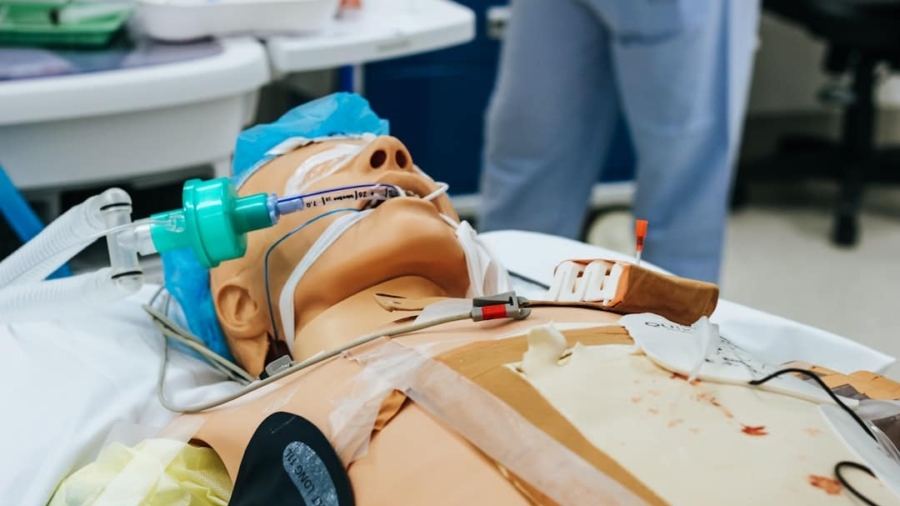Virtual Reality (VR) has emerged as a transformative technology in various fields, and its application in medical education is particularly noteworthy. The integration of VR into medical training offers a novel approach to learning that transcends traditional methods.
This technology not only enhances the educational experience but also prepares future healthcare professionals for the complexities of patient care in a controlled setting. The evolution of VR technology has coincided with advancements in computer graphics, haptic feedback, and simulation techniques, making it an increasingly viable tool for medical educators. As medical knowledge expands and the demand for skilled practitioners grows, the need for innovative training solutions becomes paramount.
VR provides a platform where students can engage with intricate anatomical structures, practice procedures repetitively, and receive immediate feedback on their performance. This immersive learning experience is reshaping how medical professionals are trained, ultimately leading to improved patient outcomes.
Key Takeaways
- VR in medical education offers immersive and interactive learning experiences for students and professionals.
- VR in surgical training provides a safe and controlled environment for practicing complex procedures.
- VR simulates surgical procedures, allowing students to practice and refine their skills in a risk-free setting.
- VR improves surgical skills and precision by providing real-time feedback and performance metrics.
- Integrating VR into medical school curriculums enhances the overall learning experience and prepares students for real-world scenarios.
The Benefits of VR in Surgical Training
Reducing Risks and Ethical Concerns
Traditional surgical training often involves a steep learning curve, where novice surgeons must navigate the complexities of human anatomy and surgical techniques under the watchful eye of experienced mentors. In contrast, Virtual Reality (VR) allows trainees to practice procedures multiple times without the ethical concerns associated with live patients.
Personalized Learning and Skill Development
This repetition fosters confidence and competence, enabling students to refine their skills before entering the operating room. Moreover, VR can accommodate various learning styles and paces. Each student can engage with the material at their own speed, revisiting challenging concepts or procedures as needed.
Comprehensive Training for Real-Life Situations
This personalized approach to learning is particularly beneficial in surgical education, where mastery of techniques is crucial. Additionally, VR simulations can be designed to mimic a wide range of surgical scenarios, from routine operations to rare complications, providing trainees with a comprehensive understanding of potential challenges they may face in real-life situations.
The Use of VR in Simulating Surgical Procedures

The application of VR in simulating surgical procedures is one of its most compelling features. Through advanced graphics and realistic modeling, VR can recreate intricate surgical environments that closely resemble actual operating rooms. Trainees can interact with virtual instruments and tissues, allowing them to practice techniques such as suturing, incision making, and tissue manipulation.
This hands-on experience is invaluable for developing fine motor skills essential for successful surgeries. Furthermore, VR simulations can incorporate various patient scenarios, including different anatomical variations and pathological conditions. For instance, a trainee might encounter a virtual patient with a unique anatomical structure or a specific disease state that requires tailored surgical approaches.
This level of customization not only enhances the realism of the training experience but also prepares students for the unpredictability of real-world surgeries. By exposing trainees to diverse cases within a controlled environment, VR helps cultivate critical thinking and problem-solving skills that are vital for effective surgical practice.
VR’s Role in Improving Surgical Skills and Precision
The precision required in surgical procedures cannot be overstated; even minor errors can have significant consequences for patient outcomes. VR plays a crucial role in honing these skills by allowing surgeons to practice intricate maneuvers repeatedly until they achieve a high level of proficiency. Studies have shown that trainees who utilize VR simulations demonstrate improved hand-eye coordination and spatial awareness compared to those who rely solely on traditional training methods.
In addition to enhancing technical skills, VR also fosters an understanding of the cognitive aspects of surgery. Trainees can learn to anticipate complications and make quick decisions based on real-time feedback from the simulation. For example, if a trainee makes an error during a procedure, the VR system can provide immediate corrective feedback, allowing them to understand what went wrong and how to rectify it in future attempts.
This iterative learning process is essential for developing not only technical skills but also the critical thinking necessary for successful surgical practice.
The Integration of VR into Medical School Curriculums
As medical education evolves, integrating VR into curricula has become increasingly important. Many medical schools are beginning to recognize the value of immersive technology in enhancing traditional teaching methods. By incorporating VR into their programs, institutions can provide students with access to cutting-edge training tools that prepare them for the demands of modern healthcare.
The integration process often involves collaboration between educators, technologists, and healthcare professionals to develop relevant content that aligns with educational objectives. For instance, some medical schools have implemented VR modules that complement existing anatomy courses, allowing students to explore 3D models of human anatomy interactively. This approach not only reinforces theoretical knowledge but also provides practical insights into how anatomical structures relate to surgical procedures.
As more institutions adopt this technology, it is likely that VR will become a standard component of medical education.
Challenges and Limitations of VR in Advanced Surgical Training

Financial Barriers
One significant limitation is the high cost associated with developing and maintaining sophisticated VR systems. The initial investment in hardware and software can be substantial, which may deter some institutions from adopting this technology. Additionally, ongoing costs related to updates and technical support can further strain budgets.
Realism and Accuracy
Another challenge lies in ensuring that VR simulations accurately reflect real-world scenarios. While advancements in technology have improved the realism of virtual environments, there remains a gap between simulated experiences and actual surgical practice. For instance, haptic feedback—essential for replicating the tactile sensations experienced during surgery—may not always be sufficiently developed in current VR systems.
Validation and Effectiveness
This limitation can hinder the transfer of skills learned in virtual environments to real-life situations. Furthermore, there is a need for rigorous validation studies to assess the effectiveness of VR training compared to traditional methods.
Future Developments and Potential for VR in Medical Education
Looking ahead, the potential for VR in medical education is vast and continues to expand as technology advances.
Additionally, improvements in artificial intelligence could lead to adaptive learning environments where simulations adjust in real-time based on a trainee’s performance, providing personalized challenges that promote skill development.
Moreover, as telemedicine becomes more prevalent, integrating VR with remote learning platforms could facilitate access to high-quality training resources for students worldwide. This could be particularly beneficial for institutions in underserved areas where access to experienced mentors and advanced training facilities may be limited. By leveraging VR technology, medical education can become more inclusive and equitable, ensuring that aspiring healthcare professionals have the opportunity to develop their skills regardless of their geographical location.
The Impact of VR on the Future of Surgical Training
The impact of virtual reality on surgical training is profound and far-reaching. As this technology continues to evolve and integrate into medical education, it holds the promise of revolutionizing how future surgeons are trained. By providing immersive experiences that enhance skill acquisition and foster critical thinking, VR is poised to play a pivotal role in shaping the next generation of healthcare professionals.
As we move forward into an era where technology increasingly influences education and training methodologies, it is essential for medical institutions to embrace these innovations thoughtfully and strategically. The potential benefits of VR are immense; however, careful consideration must be given to addressing challenges such as cost and realism in simulations. Ultimately, by harnessing the power of virtual reality, we can create a more effective and engaging learning environment that prepares surgeons not only for technical proficiency but also for the complexities of patient care in an ever-evolving healthcare landscape.
A related article to “How VR Is Supporting Medical Students in Advanced Surgical Training” can be found in The Next Web Brings Insights to the World of Technology. This article may provide further insights into the latest technological advancements that are shaping the field of medicine and education, including virtual reality applications in surgical training.
FAQs
What is VR?
VR stands for virtual reality, which is a computer-generated simulation of an environment that can be interacted with in a seemingly real or physical way by a person using special electronic equipment, such as a helmet with a screen inside or gloves fitted with sensors.
How is VR supporting medical students in advanced surgical training?
VR is supporting medical students in advanced surgical training by providing them with realistic simulations of surgical procedures. This allows students to practice and refine their surgical skills in a safe and controlled environment before performing procedures on actual patients.
What are the benefits of using VR in medical training?
The benefits of using VR in medical training include the ability to practice surgical procedures in a risk-free environment, the opportunity to repeat procedures as many times as needed to improve skills, and the ability to experience rare or complex surgical scenarios that may not be readily available in traditional training settings.
Are there any limitations to using VR in medical training?
Some limitations of using VR in medical training include the initial cost of equipment and software, the need for technical support and maintenance of VR systems, and the potential for simulation to differ from real-life surgical scenarios. Additionally, not all medical schools or training programs may have access to VR technology.

